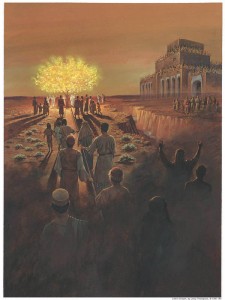by Nora
 In downtown Fresno, California, there is a large building that houses a remarkable room in a corner of the ground floor. If you walk up to the windows and look inside, you will see an amazing sight: row upon row of tiny babies, some no bigger than the palm of your hand, presided over by the best doctors and under the constant watch of nurses and parents dressed in surgical gowns and masks. Some of the babies’ faces are nearly covered by the blue tubes of ventilators; others rest more quietly under clear oxygen hoods. Some lie under bright lights, their vision completely obscured by black eye-masks. All are fighting for their lives as those who care for them hover like angels, touching, tending, watching, and praying.
In downtown Fresno, California, there is a large building that houses a remarkable room in a corner of the ground floor. If you walk up to the windows and look inside, you will see an amazing sight: row upon row of tiny babies, some no bigger than the palm of your hand, presided over by the best doctors and under the constant watch of nurses and parents dressed in surgical gowns and masks. Some of the babies’ faces are nearly covered by the blue tubes of ventilators; others rest more quietly under clear oxygen hoods. Some lie under bright lights, their vision completely obscured by black eye-masks. All are fighting for their lives as those who care for them hover like angels, touching, tending, watching, and praying.
Joseph Smith, the first prophet of The Church of Jesus Christ of Latter-day Saints (which church is sometimes nicknamed “The Mormon Church”), translated The Book of Mormon: Another Testament of Jesus Christ from an ancient record by the gift and power of God. The Book of Mormon is the religious history of a people who left Jerusalem in about 600 BC and were led by God to travel to the Americas, where they built a civilization that flourished for 1000 years. Early in their travels, while they were still only a few days’ journey from Jerusalem, their first prophet, Lehi, had a remarkable dream. He found himself wandering in a “dark and dreary waste” for many hours. After calling upon God for help, he saw a spacious field, with a path traversing it, which led to “a tree, whose fruit was desirable to make one happy.” By following the path, holding fast to the “rod of iron” which ran along it, Lehi and many of his family were able to make their way along the path, avoiding the river of filthy water that ran alongside, despite “mists of darkness” that arose to obscure their sight. When they reached the tree, Lehi says, they tasted the fruit, which was “most sweet, above all that I ever before tasted. Yea, and I beheld that the fruit thereof was white, to exceed all the whiteness that I had ever seen. And as I partook of the fruit thereof it filled my soul with exceedingly great joy” (The Book of Mormon, 1 Nephi 8:11–12).
The Tree of Life and the Love of Christ
Throughout the rest of the Book of Mormon, the tree Lehi saw is referred to as “The Tree of Life.” It becomes a central image in the religious teachings of his people and its fruit is referred to hundreds of years later as being “most precious, . . . sweet above all that is sweet, . . . white above all that is white, yea, and pure above all that is pure; and ye shall feast upon this fruit even until ye are filled, that ye hunger not, neither shall ye thirst” (The Book of Mormon, Alma 32:42). Shortly after Lehi’s dream, the fruit of the Tree of Life is explained to be symbolic of
the love of God, which sheddeth itself abroad in the hearts of the children of men; wherefore, it is the most desirable above all things. . . and the most joyous to the soul (The Book of Mormon, 1 Nephi 11:22–23).
The Tree of Life and Jesus Christ
The Tree of Life symbolizes eternal life with God and with His Son, Jesus Christ. Its fruit is the love of God, by which He sent His Son Jesus Christ to atone for us so we could return to Him. Jesus is the source of all love and all life. He created this living world; He redeemed it through His sacrifice; He has brought about the resurrection of all mankind; and through faith on His name and repentance of our sins, we can return to live eternally with God. Our souls can be filled with the love of Christ, which is most precious, sweet above all that is sweet, pure above all that is pure, the most desirable of all things, and the most joyous to the soul.
Like the tiny infants in the NICU at Valley Children’s Hospital, we are fighting for our eternal lives. We are constantly watched over and nurtured by earthly and heavenly angels, who rescue, teach, touch, and love us through every step along the path. Sometimes trials obscure our vision, like masks, like the mists of darkness; but always, our Savior, Jesus Christ, is watching over us to help us along. We may not be able to see the Tree of Life, but it is there, waiting for us. Its fruit is worth every struggle.
Additional Resources:
Amazing Grace: The Atonement of Jesus Christ






Recent Comments